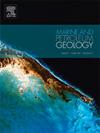巴西东南部桑托斯盆地断裂系统的时空层次及其相关的同裂谷地层序列
IF 3.7
2区 地球科学
Q1 GEOSCIENCES, MULTIDISCIPLINARY
引用次数: 0
摘要
本文利用高分辨率二维和三维地震调查,结合来自155个钻孔的地层数据,对桑托斯盆地及其外高地的1551条伸展断层进行了制图和分层。这些断裂能够控制不同时代的伸展盆地的沉积,因此将它们分为三个主要系统,以了解它们的地球动力学意义。断裂1控制了最古老的同裂谷层序,划界了最早的半地堑盆地,形成于早裂谷期。断裂2系(FS2)是中裂陷期地壳减薄的产物。断裂3系统(FS3)在裂谷晚期响应了裂谷轴向远缘的移动。引人注目的是,在晚裂谷期,整个桑托斯盆地近端区域都发生了断层再活动。这项工作很重要,因为每一个被解释的断层系统都被理解为在其活动高峰期间控制了可容纳空间的可用性,从而塑造了桑托斯盆地的内近端、外近端和远端域。这些断裂系统的演化也导致了同裂谷序列的沉积,这些同裂谷序列遵循特定的顺序或等级。通过将断裂系统与其相邻的同裂谷地层进行对比,我们提出了与桑托斯盆地各发育阶段相关的一级层序边界,这些层序边界是裂谷边缘演化过程中热力学条件变化的结果。已确定的二级层序是由地壳块体尺度上的构造运动引起的。而三、四级地层层序则与局部构造输入有关。在这个框架内,我们使用地层表面作为跨多个观测尺度的结构标志。因此,层序1SEQ1对应于伸展阶段,代表了板内环境下裂陷的初始阶段。序列1SEQ2与颈缩期和外近端构造域的形成有关,序列1SEQ3与远端构造域的发育有关,即超伸展期和大陆分裂期。最后,这项工作表明,大陆边缘的构造地层演化,从裂陷开始到大陆分裂,是由一个清晰的、历时性的构造地层记录记录的。这样的记录在分层断层系统中是不同的,这些断层系统是在多个观测尺度上形成的。本文章由计算机程序翻译,如有差异,请以英文原文为准。

Spatiotemporal hierarchy of fault systems and associated syn-rift stratigraphic sequences across the Santos Basin, offshore SE Brazil
This paper uses high-resolution 2D and 3D seismic surveys tied to stratigraphic data from 155 boreholes in the mapping and hierarchization of 1551 extensional faults across the Santos Basin and its Outer High. These faults were able to control deposition in extensional basins with different ages – they are thus classified into three (3) main systems with the aim of understanding their geodynamic significance. Fault system 1 (FS1) controlled the oldest syn-rift sequence and delimits the very first half-graben basins developed during an Early Rift stage. Fault System 2 (FS2) was formed in response to crustal thinning during an Intermediate rifting stage. Fault System 3 (FS3) responded to the migration of the rift axis towards the distal margin in a Late Rift stage. Strikingly, fault reactivation occurred throughout the entirety of the proximal domain of the Santos Basin during the Late Rift Stage. This work is important as each interpreted fault system is understood to have controlled the availability of accommodation space during its peak activity, thereby shaping the inner proximal, outer proximal, and distal domains of the Santos Basin. The evolution of these fault systems also resulted in the deposition of syn-rift sequences that obey a specific order, or ranking. By correlating fault systems with their adjacent syn-rift strata, we propose 1st-order sequence boundaries that are associated with each stage of the development of the Santos Basin, formed as a consequence of changes in thermo-mechanical conditions during the evolution of rifted margins. Identified 2nd-order sequences are attributed to tectonic movements at the crustal-block scale. In contrast, stratigraphic sequences of the 3rd- and 4th-orders are associated with localised tectonic inputs. Within this framework, we use stratigraphic surfaces as structural markers across multiple observational scales. Consequently, sequence 1SEQ1 corresponds to the stretching phase, standing for the initial stages of rifting within an intraplate setting. Sequence 1SEQ2 relates to the necking stage and formation of the outer proximal domain, whereas sequence 1SEQ3 accompanied the development of the distal domain in the so-called hyperextension and continental-breakup stages. Ultimately, this work demonstrates that the tectono-stratigraphic evolution of continental margins, from the onset of rifting to continental breakup, is documented by a clear, diachronic tectono-stratigraphic record. Such a record varies along and across hierarchized fault systems that are developed at multiple scales of observation.
求助全文
通过发布文献求助,成功后即可免费获取论文全文。
去求助
来源期刊

Marine and Petroleum Geology
地学-地球科学综合
CiteScore
8.80
自引率
14.30%
发文量
475
审稿时长
63 days
期刊介绍:
Marine and Petroleum Geology is the pre-eminent international forum for the exchange of multidisciplinary concepts, interpretations and techniques for all concerned with marine and petroleum geology in industry, government and academia. Rapid bimonthly publication allows early communications of papers or short communications to the geoscience community.
Marine and Petroleum Geology is essential reading for geologists, geophysicists and explorationists in industry, government and academia working in the following areas: marine geology; basin analysis and evaluation; organic geochemistry; reserve/resource estimation; seismic stratigraphy; thermal models of basic evolution; sedimentary geology; continental margins; geophysical interpretation; structural geology/tectonics; formation evaluation techniques; well logging.
 求助内容:
求助内容: 应助结果提醒方式:
应助结果提醒方式:


